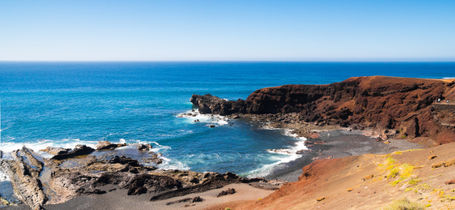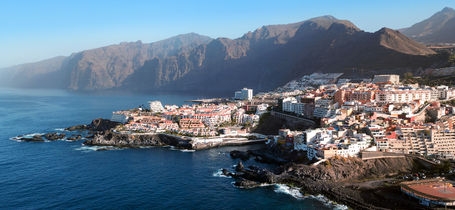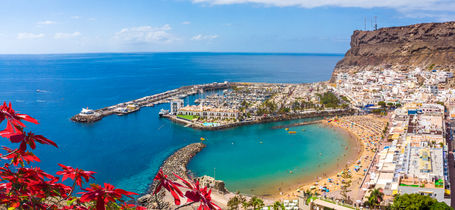Fuerteventura Diving
Fuerteventura is not only a great holiday destination above water, out in the Atlantic Ocean in the Canary Islands of Spain, but underwater it provides divers with some stunning sites; caves, caverns, a high density of marine species including Sharks and Rays and all within clear waters and in a warm climate.
Diving in Fuerteventura
Fuerteventura is the second largest island of the Canary Islands of Spain and an incredibly popular holiday destination thanks to its warm climate, pristine waters, stunning beaches and a multitude of activities to be done and enjoyed. It is surrounded by the Atlantic Ocean meaning many opportunities for some impressive diving. The island caters to a large variety of visitors, from the resort lovers to the more rugged holiday go-ers. Underwater, the island also caters to divers of all levels and all interests, including cave divers, deep divers, novice divers and dive courses. Most of the dive sites are located on the east and south coast due to these being the most protected from extreme weather conditions, but there are a few dive sites on the west coast as well. There are numerous dive centres and dive resorts on the island which will help divers experience the best of the best that this area has to offer. With a combination of thrilling rocky topography with many rock formations, shallower sandy bottom dive sites, colourful reefs and the chance to see species such as Angel Sharks, Hammerhead Sharks, Sea Turtles and many species of Rays, each dive is bound to be exhilarating in one way or another.
Best time to dive
Fuerteventura does have four seasons but luckily for divers, the temperature above and below the water does not change drastically meaning diving is possible throughout the year. The rainiest months of the year are October to January, however, it does not rain too much to hinder diving. The best diving season runs from May to September, with the warmest waters and best visibility, and the warmest outside air temperatures. The water temperatures range between 19 degrees Celsius and 24 degrees Celsius and the outside air temperatures range between 23 degrees Celsius and 29 degrees Celsius. The visibility is above average year round with an average of 25 metres and on the best days reaching over 35 metres in some diving spots.
Some of the larger species are more seasonal such as the Angel Sharks which are most commonly spotted in the winter months.
Types of diving
The different kinds of topography results in different kinds of diving opportunities for divers of all levels and with all types of interests. The main attractions are the rock formations which the volcanic rock here create, they come in the shape of thrilling canyons, caves, overhangs and arches which are most present in dive sites such as Las Salinas and Chupadera. Another formation which comes from this topography are steep walls which can be explored at multiple depths and sometimes as a drift dive. Lastly, there are also dive sites which have unique rock formations such as boulders and pinnacles which have many marine species which inhabit them. Aside from the rocky formations there are also dive sites with a sandy bottom and which are more protected allowing for relaxing dives and these are the perfect dive sites for dive courses. Some dive sites are reached by boat and others directly from shore.
What to see
The variety of underwater topography and the nutrient rich volcanic waters results in a high density of marine species which inhabit these waters, lucky for divers! There are luckily a stunning collection of corals which grow upon these rocky formations including Anemones and Anemone Fish, Sea Sponges, Hard Corals, Soft Corals, Black Corals and impressive Red Gorgonians. Among these corals swim large schools of colourful fish including Damsel Fish, Angel Fish, Parrot Fish, Bream and Barracuda. Some of the other critters which live in and among the rocks and corals are Gastropods, different species of Eels, Sea stars, Spider Crabs, Cuttlefish, different species of Eels including Moray Eels and the majestic Seahorses. Some of the larger species which attracts many divers to this area are species such as Angel Sharks which are a common sight here, different species of Rays including Eagle Rays, Stingrays and Butterfly Rays, graceful Sea Turtles and on the luckiest days there are a chance to spot Hammerhead Sharks, Dolphins and Whale Sharks. Due to the species here being in such a high abundance, every dive is bound to be an exciting or colourful one.
Best places to dive
El Veril Grande is an impressive underwater wall which drops down past 45 metres deep. If the currents are right divers are able to drift past the wall and spot an exciting collection of species including Ange Sharks, Rays, Eels and on the best days divers may be able to spot larger species such as Devil Rays or Whale Sharks out in the blue. The wall also has multiple small caves which can be explored with the right certification.
Bajon del Rio is a uniquely shaped dive site which is made up of a golden sandy bottom with unique mushroom shaped rock formations rising out up from the sand. These mushroom shaped rocks are home to a high abundance of marine species, especially many colourful school of reef fish and a collection of colourful sponges on the top. It’s a colourful dive for divers to enjoy.
El Jablito is the epitome of relaxation, this shallow shore dive is located in the protected north east part of the island, has a maximum depth of 15 metres and is still teeming with marine life. This is an ideal spot for novice divers or divers who just want to float and check out the many schools of fish and reef critters which inhabit this dive site.
Las Salinas and Chupadera dive sites are the opposite of El Jablito, there is no sand here but instead thrilling rocky topography in the shape of archways, steep walls, sharp rocky formations and crevices.


